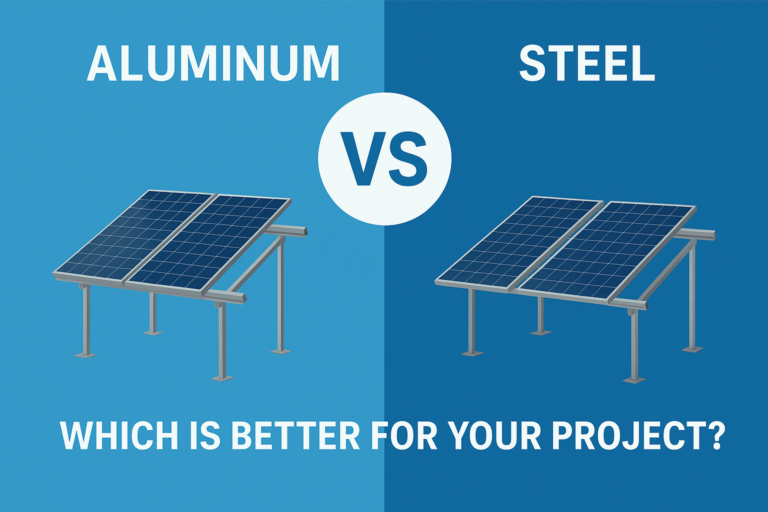When planning a solar project, one of the key decisions to make is the choice of mounting material — aluminum or steel.
Both materials are widely used in solar racking systems, but each offers distinct advantages depending on the project size, location, and budget.
This article compares aluminum and steel mounting structures to help you choose the best option for your solar installation.
1. Strength and Structural Performance
-
Steel has higher tensile strength and load-bearing capacity, making it ideal for large-scale ground-mounted solar farms and carports that face heavy wind or snow loads.
-
Aluminum, while lighter, offers excellent structural stability for residential and commercial rooftops. It’s strong enough for most medium-load applications when properly designed.
Summary:
| Material | Strength | Typical Use |
|---|---|---|
| Steel | Very High | Ground Mounts, Carports |
| Aluminum | Moderate–High | Roof Mounts, Light Ground Systems |
2. Weight and Installation Efficiency
Weight directly affects transportation, handling, and installation speed.
-
Aluminum is about one-third the weight of steel, which means faster installation, easier transportation, and lower labor costs.
-
Steel systems are heavier and may require machinery or more manpower during installation.
💡 If your project emphasizes easy handling and short construction time, aluminum is the smarter choice.
3. Corrosion Resistance and Durability
-
Aluminum forms a natural oxide layer that protects it from corrosion, especially in humid, coastal, or desert environments.
-
Steel, unless hot-dip galvanized or powder coated, can rust over time, particularly in high-moisture or salt-air regions.
However, treated carbon steel structures (Q235, Q345) have excellent durability and cost performance.
Summary:
| Environment | Recommended Material |
|---|---|
| Coastal / High Humidity | Aluminum |
| Inland / Dry Climate | Steel or Galvanized Steel |
| Industrial / Polluted Area | Aluminum (better corrosion resistance) |
4. Cost Considerations
-
Steel is generally more affordable per kilogram, making it suitable for large-scale utility projects where budget control is critical.
-
Aluminum systems cost more upfront but often save money in transportation, labor, and long-term maintenance.
📈 Total cost of ownership may be lower for aluminum systems in the long run.
5. Aesthetic and Design Flexibility
Aluminum offers a smoother surface and can be anodized or powder-coated for better appearance.
It’s also easier to extrude into customized profiles, making it ideal for architectural solar projects or carports where appearance matters.
Steel systems, while strong, are less flexible in design and typically used in utility-scale or industrial installations.
6. Environmental Impact
Both aluminum and steel are recyclable materials.
However, aluminum’s lighter weight means lower carbon emissions during transport and installation, supporting a greener lifecycle for solar systems.
7. Choosing the Right Material
The best material depends on your specific project requirements:
| Project Type | Recommended Material |
|---|---|
| Residential Roof | Aluminum |
| Commercial Roof | Aluminum or Galvanized Steel |
| Ground Mount Farm | Steel |
| Coastal Area Project | Aluminum |
| Carport Structure | Aluminum or Steel (depends on load and cost) |
Conclusion
Both aluminum and steel solar mounting structures have proven reliability in solar power projects.
If you value lightweight, corrosion resistance, and fast installation, choose aluminum.
If you need high strength and lower initial cost, steel remains an excellent option.
At Top Best Solar, we manufacture both aluminum and steel solar mounting systems, providing tailor-made solutions to meet your structural, environmental, and economic needs.
💡 Contact us today for expert advice and custom designs for your next solar project, our company website: topbestsolar.com







